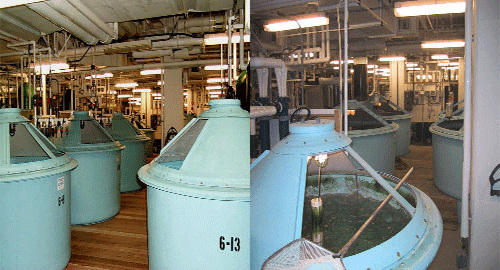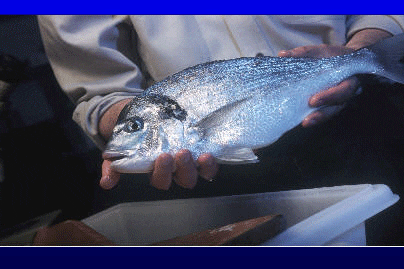Global marine fisheries have exhibited continuous declines in recent years. According to Food and Agricultural Organization (FAO) statistics, 74 per cent of the world's commercially fished species are either depleted (9 per cent), overfished (18 per cent) or fully fished. Fisheries scientists are in agreement that the oceans have attained their maximal sustainable yield, and if current trends continue, world fisheries could collapse within a few decades.
At the same time, due to the health benefits associated with a seafood-based diet, consumer demand for seafood has steadily increased. It is very clear that in order to ease pressures on wild fisheries stocks, and to satisfy the growing global consumption of seafood, marine species must be produced through aquaculture. Responding to that situation, aquaculture has been growing steadily during the last decade, and has in fact been the fastest growing sector in both US and world agricultural industries.
During the last 10 years, global aquaculture production has expanded at a rate of over 10 per cent per year, reaching a total production in 2003 of 45.7 million metric tons and a value of $56.5 billion. Despite the industry's overall growth, the culture of freshwater species still comprises about two thirds of global aquaculture production. The farming of marine species must be accelerated to meet the challenge of providing seafood to the growing world population, especially in the face of dwindling marine landings.
urban mariculture prototype in the Columbus Center:

One of the major obstacles to the development of marine aquaculture is its interaction with the environment. The potential adverse effect of net pen mariculture on the coastal and marine environment has been widely publicized and has become a source of unending controversy between environmentalists and mariculturists. At the center of the controversy is the chemical waste generated by net pens and pond farming, as well as biological interactions of farmed fish mixing with wild stocks.
However, the potential adverse effect of mariculture on the marine environment is only one side of the problem. In net pen and marine pond practices, the environment also exerts an adverse effect on farmed organisms. Fish reared in net pens or ponds are exposed to water-borne contaminants and pathogens, algal toxins and sub-optimal environmental conditions. In recent years, the scientific literature and the press have warned consumers of the potential for contamination with toxic substances of both wild fish and fish raised in floating netpens.
Responding to that situation, scientists at UMBI's Center of Marine Biotechnology (COMB) developed a new generation of marine aquaculture technologies that address and solve all the above concerns and can produce very clean fish: recirculating, fully contained marine aquaculture. Recirculating mariculture is the solution to an environmentally sustainable and economically feasible marine aquaculture, and can be established in either urban or rural communities.

The core of the system includes biological filtration units that incorporate naturally occurring microbial processes (nitrification heterotrophic/autotrophic denitrification, sulfate reduction and anammox) to control and degrade waste compounds produced by fish that otherwise accumulate in system water and can harm the fish.
The ultimate elimination of these compounds by select groups of microorganisms allows for the recycling of tank seawater eliminates the requirement of replacing or adding seawater. Moreover, the system collects and digests solid waste products that are derived directly from the fish or by the accumulation of uneaten feed to fuel additional microbial processes whose activities result in the production of methane gas, which can be captured and used as a source of energy.
The most significant benefit of recirculating mariculture is that it alleviates the potentially deleterious effect of fish farming on the environment. COMB's recirculating system can grow high densities of commercially important marine fish with 99 per cent containment of effluents, or better. The nominal amount of wastewater is disinfected and can easily be handled by a city or municipal sewer system----there is no direct waste release to the environment.
Moreover, the high percentage of recirculation efficiency, together with the disinfection of effluents, provides an increased level of bio-security.' The risk of escape of farmed organisms to the environment and, in turn, biological pollution, is significantly reduced.

The total containment and bio-security of recirculating systems make them the only aquaculture practice that can safely farm non-indigenous species. A major advantage of aquaculture over the farming of other livestock is the ability to easily diversify to multiple high-value species.
Being able to choose and alternate the species to be farmed based on their economic viability, as opposed to their geographic origin, would be highly beneficial for the industry. This is what drove COMB's efforts to develop a Baltimore-based urban mariculture approach using the high value Mediterranean gilthead seabream (Sparus aurata).
In addition to having minimal environmental impact, recirculating marine aquaculture systems have a number of advantages, making them the optimal approach for efficiently growing seafood and for future urban aquaculture expansion:
- Recirculating systems, unlike net pens or ponds, usually use municipal water for artificial seawater preparation and are thus disease free. Moreover, water is continuously disinfected and potential pathogens are eliminated.
- In recirculating systems, again unlike in ponds or net-pens, fish are grown in depurated water with no contaminants, toxins or off-flavor sources. Consequently, the produced fish are very clean' and can be marketed as such.
- Environmental conditions (water temperature, salinity, etc.) can be fully tailored to optimally fit the requirements of the fish of interest, thus ensuring optimal performance and the fastest growth rates to market size. As such, recirculating systems are generic and can be modified to accommodate the species for which the market feasibility is highest.
- Because of the excellent water quality, fish can be grown in recirculating systems at very high densities. For our marine species, those densities are much higher than the densities practiced in the net-pen industry.
- Recirculating aquaculture facilities are fully contained and thus can be located almost anywhere; they can be developed in rural or urban areas, in inner cities and in most warehouses. Site selection is not dictated by proximity to a natural source of water (e.g. lake, ocean), but rather by the business opportunity.
In the basement of the Columbus Center, COMB has established a model system for urban, recirculated, fully contained and sustainable marine aquaculture that has consistently produced large densities of the high value Mediterranean seabream. Our fish were tested by local seafood restaurants and were highly praised for their taste, texture and freshness.
July 2009




